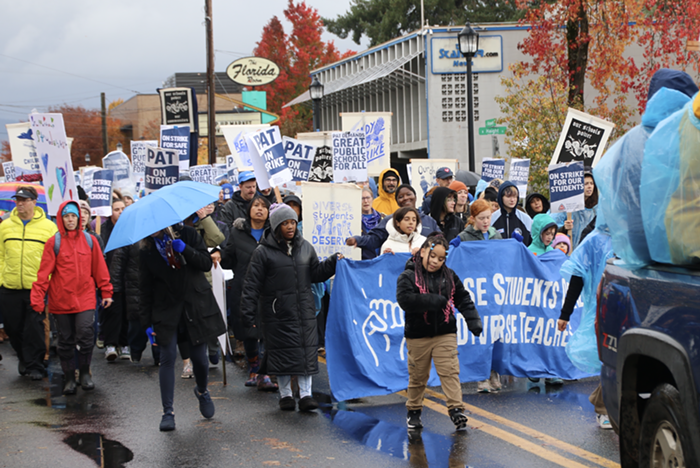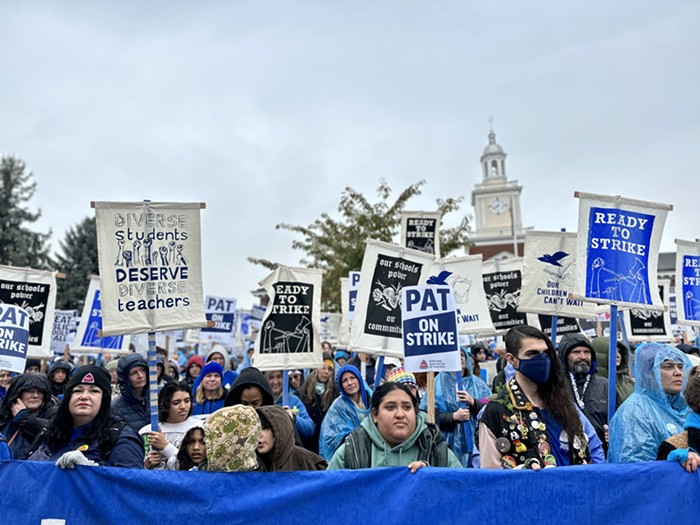
When Terrence Hayes was released from prison in 2016, he felt like he had lost more than time.
“I watched my kids grow up from behind the bars,” Hayes said. “There is not an aspect of my life today that is not a byproduct of that decision.”
Because of his felony conviction, Hayes now has trouble finding a landlord who will rent a home to him, and he isn’t always allowed to be involved in his childrens’ extracurricular activities. He works as an electrician, but is excluded from some contracts because of his felony status.
The worst part, for Hayes: “It all could have been avoided.”
Hayes was found guilty of attempted murder and five related charges in Multnomah County Circuit Court in 2004. But the jury that convicted him wasn’t in total agreement about the charges—only 10 of the 12 jurors were convinced of Hayes’ guilt, while two others voted “not guilty.” Hayes pleaded “not guilty” to all counts, and later appealed the decision, unsuccessfully.
If Hayes had been tried in virtually any state besides Oregon, this verdict wouldn’t be enough to convict Hayes. His trial would have instead resulted in a hung jury, and the district attorney’s office would then decide whether to re-try him, negotiate a plea deal on lesser charges, or drop the case altogether. But up until last year, these types of “non-unanimous” jury convictions were valid in Oregon, meaning only 10 out of 12 votes were needed to send Hayes to prison for 12 years and eight months.
Hayes is a Black man, and new data provided to the Mercury shows that in Oregon—and especially in Multnomah County—Black people are grossly disproportionately impacted by non-unanimous jury convictions. That shouldn’t come as a surprise: The practice was approved by Oregon voters in 1934 following an explicitly xenophobic campaign, and a similar rule in Louisiana was enacted in the Jim Crow era to make it easier to convict Black defendants. The logic behind these policies: It’s less difficult to convict people if you don’t have to convince an entire jury of their guilt—and it’s particularly easy to convict people from minority groups if the rare sympathetic juror, or the sole juror of color, can be disregarded. Oregon and Louisiana are the only two states to have ever allowed non-unanimous jury convictions.
“The increased urbanization of American life, and the vast immigration into America from southern and eastern Europe, of people untrained in the jury system, have combined to make the jury of twelve increasingly unwieldy and unsatisfactory,” reads a 1933 Oregonian editorial advocating for non-unanimous convictions.
For Hayes, the knowledge that his fate was shaped by this overtly racist policy makes his conviction sting even more.
“A jury of my peers is supposed to come from different backgrounds, different understandings,” he said. “Those two jurors who clearly saw a different story—their voices were silenced.”
This system of allowing non-unanimous juries to convict people of felonies was found unconstitutional by the US Supreme Court in April 2020. In the case, Ramos v. Louisiana, the court’s 6-3 decision ensured that moving forward, nobody in the US can be convicted of a felony by a non-unanimous jury. It also ensured that Oregonians who were in the middle of their appeals process would have their non-unanimous convictions reconsidered by the courts.
But the Ramos ruling didn’t determine what would become of people like Hayes—an unknown number of people, dating back to 1934, who have already been convicted, attempted to appeal the verdict, and served some or all of their prison sentences. Oregon Attorney General Ellen Rosenblum has already expressed resistance to vacating these cases, raising concerns that the process would overwhelm the court system. Legal experts, meanwhile, argue that ignoring these cases would be unconstitutional. With the US Supreme Court expected to clarify this gray area later this year, Hayes and other Oregonians convicted by non-unanimous juries are wondering whether they will once again be let down by Oregon’s legal system.
“If you’re a Black defendant, and you have a jury in Oregon, what’s the chance that that’s going to be a jury of your peers?”
Aliza Kaplan, a professor at Lewis & Clark Law School and director of the school’s Criminal Justice Reform Clinic, had fought to overturn Oregon’s policy allowing for non-unanimous jury convictions long before the Supreme Court’s Ramos ruling. For Kaplan, it’s obvious that the policy was used to further exacerbate racial disparities in Oregon’s criminal court system.
“I have no doubt that we of course use non-unanimous juries in that way,” Kaplan said. “If you’re a Black defendant, and you have a jury in Oregon, what’s the chance that that’s going to be a jury of your peers?”
Only 2 percent of people in Oregon are Black, making it one of the least racially diverse states in the country.
The Ramos ruling wasn’t retroactive, meaning that it doesn’t apply to cases that have already gone through the conviction and traditional appeals process. But because the Ramos ruling solidified the idea that non-unanimous felony convictions are inherently unconstitutional, legal advocates like Kaplan believe that means Oregon’s settled non-unanimous convictions deserve to be reconsidered.
That belief could be upheld by another legal case the US Supreme Court is set to rule on this year. The case, Edwards v. Vannoy, raises the question of whether the Ramos decision—that non-unanimous juries are fundamentally unconstitutional—should be retroactively applied to old cases. If the court rules in favor of retroactivity in Edwards v. Vannoy, Oregon District Attorneys will be forced to reconsider cases like Hayes’.
The Edwards case is out of Louisiana, and some district attorneys in Louisiana are already granting new trials to those with split-jury convictions. But in Oregon, individual district attorneys can't grant retrials for post-conviction cases without the blessing of the attorney general, meaning Rosenblum would have to initiate it.
But even if the Supreme Court rules against retroactivity, that wouldn’t prohibit Oregon from making the Ramos ruling retroactive. That’s because some states, including Oregon have the freedom to not follow the same retroactivity precedents established in federal court.
In the meantime, Oregonians with settled non-unanimous jury convictions are seeking post-conviction relief, meaning they are petitioning to have their cases reversed—or at least retried—after the fact. Some of these people are still serving their prison sentences for their now-unconstitutional verdict, while others, like Hayes, have finished their prison terms.
Until now, Kaplan said, she’s had trouble finding the data to back up the belief that split-juries convictions have had racially disproportionate outcomes. That’s because not every non-unanimous jury decision is recorded—and ones that are recorded haven’t been easy to find. That changed after Ramos.
Kaplan has been working with legal advocacy organization Zealous to collect data on Oregonians who file for post-conviction relief after receiving a non-unanimous conviction, and request a publicly funded lawyer—as most people seeking relief do. As of late January 2021, they had counted 205 people—about 18 percent of whom are Black.
The racial disproportionately becomes even more pronounced in Multnomah County, the state’s most populous county, where 25 out of 54 people seeking post-conviction relief are Black. That’s 46 percent, compared to 5 percent of the county’s general population.
Kaplan stressed that these numbers aren’t an exhaustive representation of non-unanimous convictions in Oregon. Rather, they represent cases in which people can prove their juries were non-unanimous, and in which the defendants have chosen to file for post-conviction relief and request a publicly funded lawyer. But she said they do serve as an “important snapshot” of how the practice perpetuated racial inequity—and continues to do so, as these old cases remain unresolved.
It is up to Oregon courts to set a precedent determining whether folks filing for post-conviction relief deserve to have their cases reconsidered. But Rosenblum, Oregon’s attorney general, has the power to vacate the existing cases seeking post-conviction relief without needing to go through the courts—and it’s not likely that she will.

Rosenblum has publicly supported the Supreme Court’s Ramos decision. But before the Supreme Court ruled on Ramos, Rosenblum also warned that making the new policy retroactive could “require new trials in hundreds, if not thousands, of cases,” which would overwhelm Oregon’s criminal courts and district attorneys’ offices.
“The [state] courts will decide whether the law supports granting post-conviction relief based on Ramos, not the Attorney General,” said Katrina Edmundson, a spokesperson for Rosenblum, in an email to the Mercury. “Then, whatever cases are sent back for retrial will be handled by the 36 county [district attorney] offices. [Rosenblum] is very supportive of this process and will do everything in her power to ensure the justice system is not overwhelmed by these important cases.”
Kaplan said her data suggests that it’s unlikely the courts would be overwhelmed with post-conviction relief cases should the Ramos decision become retroactive.
“This idea that there’s thousands—or hundreds and hundreds even—is incorrect,” she said. “And even if there were, I would argue it’s still people’s constitutional rights, and that should trump any financial interests or ‘too busy to handle it’ claims.”
If the Supreme Court doesn’t require retroactivity in its Edwards ruling, the issue will probably need to be settled through precedent-setting cases in the Oregon court system, which would likely work their way up to the Oregon Supreme Court.
“I want the Oregon Supreme Court to tell these 205-plus people with known non-unanimous juries that their case just happened at the wrong time, and their constitutional rights don’t matter,” Kaplan said. “I want our highest court to do that. They’re going to have to do that.”
“They’re talking about overwhelming the courts. What about my life?"
Hayes is now in the process of filing for post-conviction relief. The judge presiding over his case back in 2004 was Rosenblum—now the attorney general who is hesitant to vacate cases like Hayes’.
“They’re talking about overwhelming the courts,” Hayes said. “What about my life? What about the anxiety, the stress, the overwhelming everyday feelings of being marked as a felon? They’re not concerned with that, but they’re concerned about the [district attorneys] having to do their jobs?”
Hayes knows he’ll never get back the time he lost in prison. He’ll probably continue to feel anxious in grocery stores, with the waxed floors and fluorescent lighting that remind him of prison. He’ll struggle with his relationships with his wife and their eight children and step-children, and he’ll be at higher risk of diabetes and high blood pressure because of the diet he was fed while incarcerated.
But post-conviction relief, if it leads to his record being expunged, could open new doors for him. He’ll be able to get more work as an electrician, and it will be easier for him to rent a home. He’ll be allowed to coach his son’s football and basketball teams, because he won’t have a violent felony on his record.
And, Hayes said, it will give him a new sense of himself.
“When that does not have to define me, it immediately changes what people see when they deal with me,” he said. “And it changes how I see myself... It’d be nice to get a little redemption. I’m looking for my person back, and to not have to answer for a crime I was convicted of unconstitutionally.”



















